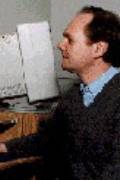
John Kubie, PhD
Associate Professor
Department of Cell Biology
Our lab focuses on the function of the hippocampus. Most of the work is collaboration between Dr. Kubie, Dr. Robert Muller in the Department of Physiology, and colleagues. Analysis of Hippocampal Place Cells is the principal focus of investigation. Place cells are pyramidal neurons that fire rapidly only when the animal (rat) is in a restricted portion of the environment the firing field. The existence of place cells is powerful evidence that the rat hippocampus is part of a cognitive mapping system that helps the rat navigate through its environment. The second direction of investigation involves behavioral studies of Navigation Behavior. We investigate the effects of hippocampal lesions on navigation, and we are beginning to investigate the firing properties of place cells during complex navigational tasks.
A central question is how populations of cells contribute to an animal's perception of space. To begin to address this, we have initiated studies in which many (greater than 10) neurons are recorded simultaneously. We have recently developed systems with multiple electrodes and computer systems capable of collecting data from these recording arrays.
A second critical question is to determine how cells acquire the representation of a new environment. To address this, we have begun to analyze place cell firings in novel environments, and we have begun to analyze the relationship of one form of synaptic plasticity Long Term Potentiation to place cell firings.
We have recently developed a behavioral task that clearly demonstrates the rat's spatial capabilities. Lesions of the major connections of the hippocampus severely and permanently impair the rat's performance on this task. We are in the process of recording from place cells in rats while they are performing this task to determine the degree to which place cell activity can account for a rat's behavior.
Finally, efforts to develop computer models of the hippocampus are underway. Our principal aim is to see if we can make computer simulations of the network of hippocampal neurons that can solve the navigational problems that rat hippocampus solves.
- Kubie, J. L., R. U. Muller, and E. Bostock. 1990. Spatial firing properties of hippocampal theta cells. Journal of Neuroscience 10:11101123.
- Quirk, G. J., R. U. Muller, and J. L. Kubie. 1990. The firing of hippocampal place cells in the dark reflects the rat's recent experience. Journal of Neuroscience 10:20082017.
- Sharp, P. E., Kubie, J. L., and R. U. Muller. 1990. Firing properties of hippocampal neurons in a visually symmetrical stimulus environment: Contributions of multiple sensory cues and mnemonic processes. Journal of Neuroscience 10:30933105.
- Bostock, E., R. U. Muller, and J. L. Kubie. 1991. Experiencedependent modifications of hippocampal place cell firing. Hippocampus 1:193206.
- Kubie, J. L. and R. U. Muller. 1991. Multiple representations in the hippocampus. Hippocampus 1:240242.
- Muller, R. U., J. L. Kubie, and R. Saypoff. 1991. The hippocampus as a cognitive graph (abridged version). Hippocampus 1:2243246.
- Muller, R. U., J. L. Kubie, E. M. Bostock, J. S. Taube, and G. J. Quirk. 1991. Spatial firing correlates of neurons in the hippocampal formation of freely moving rats. In: Brain and Space J. Paillard, editor. Oxford University Press, 296333.
- Quirk, G. J., R. U. Muller, J. L. Kubie, and J. B. J. Ranck. 1992. The positional firing properties of medial entorhinal neurons: Description and comparison with hippocamal place cells. Journal of Neuroscience 12:19451963.
- Muller, R. U., E. Bostock, J. S. Taube and J. L. Kubie. 1994. On the directional firing properties of hippocampal place cells. The Journal of Neuroscience, 14(12) 723572251.